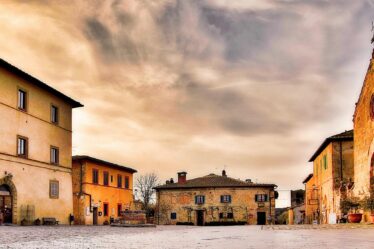

Florence, 1428: A City at Its Peak
Florence in 1428 was a city at the height of its splendor, a crossroads of art, commerce, and power. Amidst its bustling streets and towering palaces, a new architectural vision was taking shape: the construction of the Church of Santo Spirito. This project was destined to leave a lasting mark on the city’s skyline. The responsibility for its development fell to Stoldo di Leonardo Frescobaldi, an official overseeing the project. He turned to none other than Filippo Brunelleschi, the brilliant architect who had already revolutionized Renaissance architecture with his groundbreaking works.
Brunelleschi’s Bold Proposal: A Monumental Piazza on the Arno
The Unfinished Vision of Brunelleschi: Brunelleschi, known for his audacious ideas, proposed a radical design: orienting the church’s façade towards the Arno River, transforming the “Fondaccio”—an area between Via dei Serragli and Via Maggio—into a grand piazza. His vision was clear: to create a monumental space that would welcome merchants and travelers from Genoa, Lunigiana, Pisa, and beyond, showcasing Florence’s architectural magnificence before they even entered the city.
Had this plan been realized, it would have reshaped not only Santo Spirito but also the urban landscape of Florence, reinforcing the city’s status as a beacon of Renaissance innovation.
Opposition from Florence’s Powerful Families
However, this ambitious project quickly met fierce resistance. The powerful families who owned properties in the Fondaccio saw Brunelleschi’s vision as a direct threat to their real estate interests. Vasari, in his historical accounts, lamented the missed opportunity, writing:
“He strove to have the layout of the building reversed entirely […] but certain individuals, unwilling to demolish their houses, refused.”
Despite Brunelleschi’s insistence, the project was ultimately modified to accommodate these influential landowners. The opportunity to create a grand riverfront piazza was lost forever.
A Church Transformed: Modifications Over Time
The Unfinished Vision of Brunelleschi, even after Brunelleschi’s death, the construction of Santo Spirito continued, but with significant alterations to his original plan. Influential figures such as Paolo del Pozzo Toscanelli, Giuliano da Sangallo, and even Lorenzo the Magnificent contributed to the project, yet none could fully preserve Brunelleschi’s revolutionary vision.
This raises an intriguing question: what would the Fondaccio have looked like had his plans been realized? Antonio di Tuccio Manetti, Brunelleschi’s biographer, later wrote that had the Church of Santo Spirito been completed as intended, it would have been “a marvel without equal among Christians.”
A Lost Masterpiece and a Lasting Legacy
Today, as we walk the streets of Florence, we can only imagine what could have been. The Church of Santo Spirito remains a masterpiece of Renaissance architecture, yet it also stands as a reminder of unfulfilled ambition. The Arno, a silent witness to history, continues to flow, carrying with it the secrets of a dream that was never brought to life.
Learn More About Santo Spirito and Renaissance Florence
For further reading on Florence’s architectural history and Brunelleschi’s works, visit:


